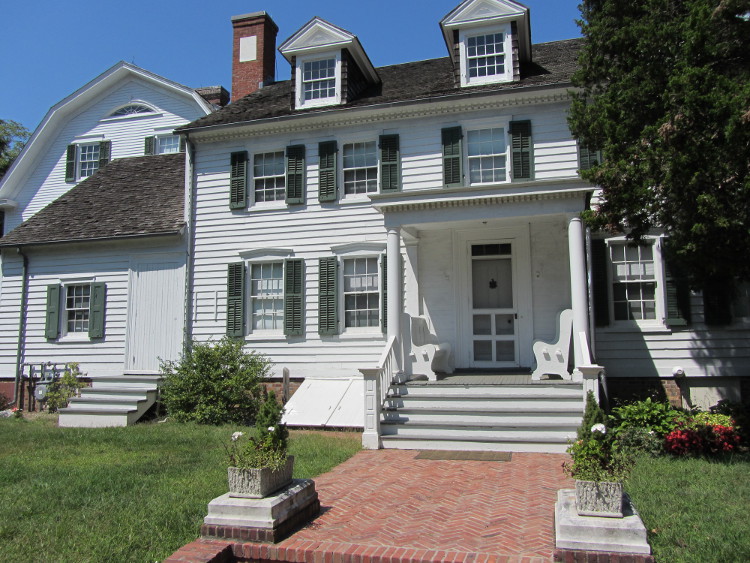A little-publicized recent New York State appeals court decision could wind up depriving Suffolk County of millions of dollars that would go a long way to help maintain Long Island’s priceless history.
The Sagtikos Manor Historical Society, a nonprofit group of volunteers who have a custodial contract with the county to run one of the most historic properties on LI, had sued to unseat the trustees of the Robert David Lion Gardiner Foundation, which has an estimated $81 million in its trust fund. The society claimed in a lawsuit that the foundation was abusing the trust and forsaking the intention of its founder to preserve the manor, his family’s ancestral home in West Islip.
“It’s a lot of money and the taxpayers are left holding the bag,” says Larry Donahue, a former Suffolk County judge and long-time board member of the Sagtikos Manor Historical Society, who had filed the lawsuit.
Late last month, the state Appellate Division reversed a supreme court ruling and dismissed the society’s lawsuit in a case that was said to have potentially far-reaching repercussions in the state’s regulation of charitable foundations. The trial court had ruled that the historical society had standing to sue, but the Appellate Division unanimously reversed that decision.
It’s just another strange chapter in the ongoing saga of the Sagtikos Manor and the last Gardiner to call it home.
No other place on Long Island can claim that both British Gen. Henry Clinton and Gen. George Washington slept under the same roof—although when Washington spent the night there in April 1790 he was the president and refused to sleep in the same bed his former enemy had occupied during the Battle of Long Island, opting instead for the room across the hall.
READ MORE: Sagtikos Manor Holds Three Centuries of Long Island History Under One Roof
The original part of the Sagtikos Manor dates back to 1697. Then the manor got a major upgrade—in 1772. The owners were content through the 19th century, at least with the exterior; they had other things on their minds. One of the Gardiner daughters, Julia, married President John Tyler. She was only 23 when he started courting her, but as First Lady Julia “captivated Washington with the size and brilliance of her White House receptions,” according to Tyler’s website. When the 20th century came, the manor got its newest—and last—addition in 1902.
At one point the Sagtikos Manor estate ran north from the Great South Bay to about a mile from the Smithtown line. Over time the 1,200-acre property kept shrinking as LI’s population kept growing. The family donated about 233 acres to the state so Robert Moses could build the Sagtikos Parkway. About 900 acres remained when Robert Gardiner’s aunt, Sarah Diodati Gardiner, sold her nephew the property for about a dollar. He would often spend his summers there but in 1961 once he married Eunice Oates, a British model many years younger than him, he stopped being a regular because she wanted to live in a relatively newer home in East Hampton.
Despite his absence, he restricted the historical society’s access to the first floor, which prevented them from doing any archiving upstairs. A couple of years ago, Sarah Faye Meurer, the current president of the historical society, discovered the original deed in a well-worn manila envelope buried in a box. It was from 1692, when the Secatogue Indians signed away their property rights forever.
In 2002, Suffolk acquired the remaining 10.9 acres for more than $1.5 million from Gardiner in a transaction handled by his attorney, Joe Attonito. The eccentric millionaire was then over 90 years old, and by many accounts nearly blind. Islip Town Supervisor Angie Carpenter was a county legislator when she first heard from the community that the manor property was about to be subdivided. She pushed the county to acquire the estate from the Gardiner Foundation. Gardiner died in 2004.
It wasn’t the first time Gardiner had sold off part of his holdings. In the early 1970s he’d unloaded 231 acres on the other side of Montauk Highway from the manor. Today it’s known as Gardiner County Park.
The Sagtikos Manor is only one of the more than 200 historic buildings that Richard Martin, director of historic services for Suffolk County Parks, has to maintain. It’s certainly one of the oldest since the majority of these holdings date back to the 19th century. The maintenance doesn’t come cheap.
The county just spent $250,000 of its capital funds to replace the wooden roof on the west wing of the main house as well as the front and rear porch roofs of the west wing. The next big project, pegged to cost $300,000, involves installing an irrigation system for the whole interior of the walled garden, where the peacock fountain is, and a full restoration of the grounds. Archaeologists reportedly just finished their examination and didn’t unearth any relics that could derail further digging. The money for the garden project is coming from a matching grant from the state.
“The plans are done and now we are putting it out for bid,” Martin tells the Press. In the meantime the volunteers have been making due with a bucket brigade from the manor.
Martin says his department hopes to restore a caretaker’s room inside the carriage house behind the manor so the historical society could have its office there. Currently, it occupies space on the second floor. Eventually, Martin says the carriage house will become a visitors’ center with a parking lot beside it. At present, people park on the back yard between the manor and the walled garden. There are no public restroom facilities inside the manor. Most of the existing plumbing is more than a century old.
The Appellate Court decision won’t alter the county’s approach to the manor.
“It’s our responsibility to restore it,” Martin says, “and the county knew that when they purchased it, so we just continue with the restoration.”
For that matter, at least for now, the legal ruling doesn’t change the Sagtikos Manor Historical Society’s commitment to the site’s upkeep.
“It really doesn’t mean anything but the principle of the thing,” says Meurer, the society’s president. “We’ve had people call us and ask, ‘Why is the manor not being restored?’ Because we personally don’t have the money. Everyone’s a volunteer. We do it all from the bottom of our heart.” She pointed out that replacing the peeling wallpaper on the main floor is estimated to cost more than $75,000 alone.
Any gain from the lawsuit would have gone to the manor, she insisted, not to the society. Unlike the Vanderbilt Museum, no one gets paid to run the Sagtikos Manor, and that’s why its hours of being open to the public are so limited. Meurer said the society’s project for 2015 is to try to upgrade the electricity so they can host evening programs.
“Bob Gardiner was very much involved with the history of Long Island. He was involved in it. He felt like he was key to it,” says Meurer, who became the society’s president last year.
Meurer confirms that the society has never applied for a grant from the foundation, adding that “they now have the grant requirements on their website which wasn’t there four or five months ago.”
“There was nothing put out about how one would apply for a grant,” says Norma Meder, the society’s director of docents. “There was no address as to who to send it to.”
She doesn’t view the Appellate ruling as a defeat.
“I don’t think we totally lost, because what we really wanted was to find out what they were doing,” says Meder. “We wanted them to be more transparent.”
She says the foundation wasn’t filing its paperwork with the IRS in a timely fashion, if at all, until the society initiated its lawsuit. “We didn’t hear about any money being given… As far as we know, they had not given any grants to anyone in New York State,” she says.
Still, Meder and other society members doubt that the foundation is living up to Robert Gardiner’s vision for Sagtikos Manor.
“Mr. Gardiner always said he had a plan, and we would certainly be included in it and so on, but he never said he was going to leave us the money, and we didn’t expect it,” she tells the Press. “He never promised us a rose garden!”
She says Gardiner told the society while he was alive that “we would be taken care of,” but she interpreted that to mean only that he would ensure that the historical mission of the Sagtikos Manor would be continued.
“We can’t make a big stink out of it,” she says. “Now we know where to apply for a grant!”
“There’s so much history involved you would think that the foundation would be eager to support it in every sense of the word, instead of them having to apply for grants!” says Nancy Donahue, who became the society’s president in 1987 and met Robert Gardiner “many, many times.”
She says he wanted to have Sagtikos preserved and he had transferred the manor to the Gardiner Foundation in 1985.
“You have to realize that this was his heritage. It was something very dear to his heart,” she says. And if Gardiner were alive today, she says, “I don’t think he’d be happy. I really don’t.”
She stepped down from her role in the society a decade ago, but her husband, Larry Donahue, is still active on the board as an honorary trustee. A former Suffolk District Court Judge for 17 years, he filed the society’s lawsuit pro bono in 2012 and got an unexpected lesson in how civil courts work.
“I was a criminal court judge, and things are different,” he says. “In criminal part, things have to be done because a guy may be sitting in jail. In civil court, you throw papers into the court, you stand around and you wait and you wait and you wait.”
It took the society three years to find out on April 22 that it had no standing to sue.
That wasn’t Donahue’s first legal entanglement with the foundation or its attorney, Attonito. Right after the county bought the manor, he found out that the antiques were about to be auctioned at Christie’s in Manhattan and an auction house in Moriches. He filed a formal complaint with then-State Attorney General Eliot Spitzer because that office regulates charities. The furnishings were part of the manor, not for sale. The auction was stopped, and Donahue credited then-Legis. Ricardo Montano (D-Brentwood) for expediting the complaint.
“I live about a mile away from the manor and I saw a light in the second story,” Donahue recalls. “I thought that was strange. And a week later it was still on. Then somebody [in the society] said that Bob had mentioned auctioning off some of the furnishings. But I’m not sure he was in his right mind when that was happening.”
Donahue speculated that Attonito may have been doing that “all on his own.” The former judge and his wife knew Gardiner quite well but had no contact with him in the last years of his life.
“This attorney has everything, and Bob would not be happy with that,” Donahue speculates. “He wound up as executor of the estate, the trustee of the testamentary trust under the will, and trustee of the foundation.”
One of the trustees now lives in Eunice Gardiner’s house in Palm Beach. According to Donahue, she changed her will six days before she died in 2011 at the age of 82, leaving “her entire residuary estate” to Attonito, and the other trustees, James H. Mahoney and Robert Watson, plus the attorney who drew up the will.
Donahue said the historical society started the lawsuit in 2012 because of financial irregularities they claimed they’d uncovered in the trust. But their concerns dated back a decade before that when Attonito announced he was changing the foundation’s mandate.
“In 2002, Attonito said he was changing the charitable purposes and that was it,” says Donahue. “We wanted a declaratory judgment stating what the charitable purposes were. The second thing was to get rid of these people, and the third was to get an accounting.”
The lawsuit stipulated that the society would “not receive any funds directly as result of the disposition of this case. The ownership of the Manor by Suffolk County is not being challenged.”
But the foundation was indeed the target.
Asked to describe the foundation’s relationship to the Sagtikos Manor, one volunteer turned bitter and would only comment anonymously.
“I don’t think they care,” the volunteer says. “But what are we going to do? You can’t make the foundation do anything.”
Attonito, the attorney and chairman of the board of trustees of the Robert David Lion Gardiner Foundation, tells the Press that the foundation has “adhered fully to its mission which is to increase awareness and education of Long Island heritage through grants that support restoration, preservation, education, research, community awareness, exhibitions, and building the capacity of history-based non-profit organizations.”
Last year, he said the foundation distributed close to a million dollars in grant funds and this year “we aim to provide over $3,000,000 in new grants.” He disputed the historical society’s claim that its lawsuit had cleared the air of any doubts about his group’s operation.
“The foundation has always reported with complete transparency all of its distributions and business expenses,” Attonito said. “The foundation understands the importance of Sagtikos Manor. However, Sagtikos is one of many historic sites on Long Island that play a significant role in local history.”
A spokeswoman for Attorney General Eric Schneiderman says that the ruling was in “our favor,” because the AG’s office was representing the state’s ability to be the sole regulator of charities and the sole party to bring cases against charities. But she would not comment further on the decision, nor say whether Schneiderman is investigating the foundation.
Suffolk County Attorney Dennis Brown was content with the outcome even if it means the parks department must depend on the kindness of the foundation’s trustees for any money to maintain the county’s historic properties, the manor in particular.
“The Appellate Division decision was a sound decision and the county does not plan on appealing,” Brown tells the Press. “The county will explore opportunities for grant funding through various means including the David Lion Gardiner Foundation.”
Former judge Donahue vehemently disagrees.
“Why the county didn’t take over this lawsuit and prosecute it themselves is another question,” Donahue says. “I’ve always felt we had the law on our side, we had the facts on our side, and that there was no way we could possibly lose this lawsuit. That was my feeling all along. The lawsuit was to get rid of these people.”
Donahue notes that the Attonito gets $125,000 a year plus $50,000 in pension from the foundation, and the other trustees are also compensated, according to the IRS filings. As for the historical society getting grants from the foundation, Donahue is skeptical.
“From their website, I understand it has to be a matching grant,” he says. “If we need a million dollars, we’d have to put up half a million. We can’t do that.”
Two Mondays ago, the volunteers were greeted by an unwelcome sight when they walked into the manor. The ceiling in the butler’s pantry was bubbling. The next day the ceiling had turned green and yellow.
“We’ve had water damage before, and if it’s not handled right away, the ceiling falls down,” says Meder. “We can ask the county to fix that because it’s a danger.” But to take care of the plumbing won’t come cheap.
The next meeting of the Sagtikos Manor Historical Society’s board of trustees is Tuesday, May 12. Donahue says he sees no purpose in further litigation. He worked for free. The foundation paid its Manhattan-based law firm, Wilkie Farr & Gallagher LLP, at least $400,000, according to IRS filings.
“We’re finished,” says Donahue, his voice heavy with regret. “The Appellate Division has said we have no standing. We have no standing. We have nothing.”





























